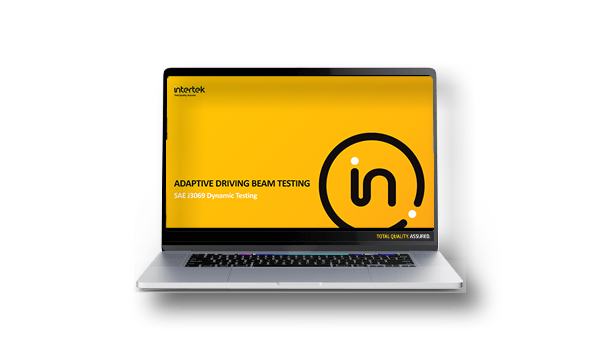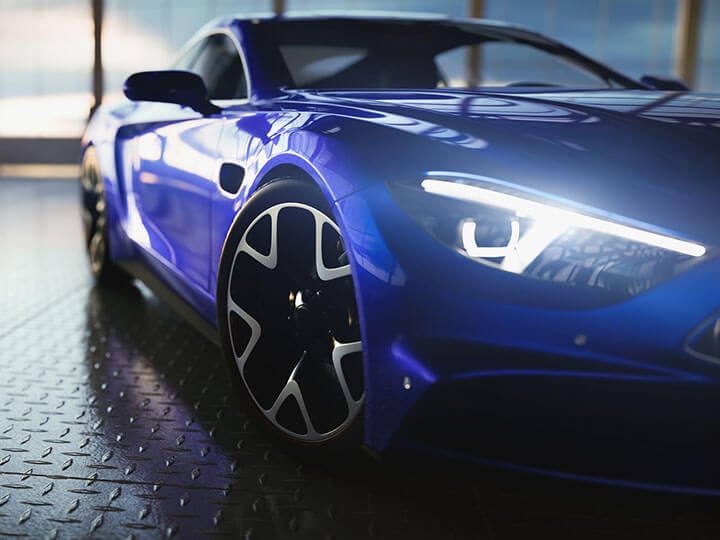Extensive photometrics testing capabilities for Adaptive Headlights with proving grounds access
What are Adaptive Headlights or Adaptive Driving Beam (ADB) Headlights?
Adaptive headlights or adaptive driving beam (ADB) headlights, also known as dynamic or swiveling headlights, are a type of automotive lighting system that can adjust the direction and intensity of the headlight beams based on the vehicle's speed, steering angle, and other factors; such as automatically lowering their brightness when oncoming traffic is detected, allowing additional lighting to show pedestrians, bicyclists or wildlife on the edges of the road, and even adjusting for climatic conditions such as rain, fog and snow.. The purpose of adaptive headlights is to improve visibility and safety while driving, particularly in challenging or low-light conditions. ADB headlights effectively remove the compromise between glare and illumination and the need for the operator to manually switch between upper and lower beams.
There are several types of adaptive headlights, but the most common ones use motorized swiveling lenses or light sources to direct the beam in the direction of the vehicle's turn. This allows the driver to see further ahead around corners and curves, and helps to avoid accidents caused by insufficient visibility. Some adaptive headlights also use sensors to detect oncoming traffic and adjust the beam to avoid blinding other drivers.
The United States has received a very welcome update to the FMVSS 108 headlight standard – the official allowance of adaptive beam headlights for US autos. Adaptive beam headlights have been allowed in virtually every country in the world up to this point, and they offer major benefits to drivers. Basically, the system allows the driver to use the full high beam setting at all times and a computer, controlled by sensors, adjusts the lighting to meet the conditions.
Benefits of Adaptive Headlight Testing
There are several benefits in testing your Adaptive Headlights, including:
- Safety - Adaptive headlights can significantly improve driver visibility and reduce the risk of accidents, particularly in low-light or challenging driving conditions. Testing ensures that these systems are functioning properly and meeting safety standards specified in FMVSS 180, which can help prevent accidents and save lives.
- Compliance - Automotive manufacturers must comply with various safety regulations and standards, including those related to ADB headlights. Testing ensures that the headlights meet these requirements and that the manufacturer is in compliance with relevant laws and regulations.
- Performance - Testing helps to ensure that the adaptive headlights are performing optimally and meeting the design specifications. This can help to identify any issues or defects that may affect the performance of the ADB headlights and provide feedback to manufacturers on how to improve their products.
- Consumer satisfaction - Adaptive headlights are a desirable feature for many drivers and can increase the value of a vehicle. Testing helps to ensure that the headlights meet consumer expectations and that they function as advertised, which can help improve customer satisfaction and brand loyalty.
- Innovation - Testing can also drive innovation in adaptive headlight technology, by identifying areas for improvement and helping manufacturers to develop new and better systems. This can lead to more advanced and effective ADB headlights in the future, further improving driver safety and comfort.
What are Adaptive Driving Beams (ADB) and SAE J3069, and how will they effect the future of mobility? Find out more with our complimentary on-demand webinar.
Intertek's Adaptive Headlights Testing Solutions
The testing requirements for ADB headlights include all the traditional physical and photometric tests for headlamps, as well as specific logic requirements for when / where the beam must meet the low beam photometric requirements the upper beam photometric requirements, and when it can be in a transition zone. In addition, the NHTSA final rule adds a full system level dynamic test in order to prove that the ADB system will not result in excessive glare to oncoming drivers. The new dynamic test includes:
- Dynamic testing: Includes a complete matrix of test drive scenarios including multiple driving speeds and turn radii at a set of stimulus vehicle fixtures all of which include a 220-meter test section over which a test vehicle must maintain a constant speed.
- During each test drive lux measurements are made at representative locations to establish glare limits for the ADB system.
- Stimulus fixtures: Comprised of oncoming and preceding vehicles and motorcycles. Each fixture includes representative headlights or tail lights as well as glare sensor locations typical for a driver's eye or mirror locations.
- Test drive: Glare limits are set at specific test distances from 220 meters to 15 meters between the ADB vehicle and the glare sensors. The test track must be flat and the vehicles path must not deviate by more than +/- 0.5 m from the specified path.
- The standard requires minimal extraneous ambient light (from reflective or other natural or man-made sources) within the immediate field of view of the glare sensors or ADB vehicle.
- Data acquisition: Illuminance data must be collected for each glare position at a minimum rate of 100Hz, and passed through a low-pass filter at 35 Hz. Additionally the photometers must be cosine corrected (to within 3%) and allow a maximum incidence angle of 25-degrees.
Intertek can assist OEMs and headlamp suppliers get their ADB headlights and systems into the US market with our extensive photometrics testing capabilities and proving grounds access. Contact us today for more information on how our Total Quality Assurance expertise can bring your A.D.B. headlamps to the roadways.
Knowledge Center
Low Voltage Lighting Products Testing and Certification Fact Sheet
Considerations in Bringing a Germicidal Product to Market Webinar
Commercial Displays: Compliance to ANSI/UL 970 Fact Sheet
Lighting for Hazardous Locations Fact Sheet
Germicidal Lighting Fact Sheet
Horticultural Lighting Safety & Performance Criteria Fact Sheet
Product Listing & Marking Strategies White Paper
Mitigating Cyber Threats to Connected Lighting Products Webinar
Automotive Lighting: Photometric Concepts, Calibration, and Measurement White Paper
Class P Program for LED Light Engines Fact Sheet
ANSI/UL 8750: Overview and Tips for Manufacturers
Ingress Protection for Lighting Products IP vs. NEMA Ratings White Paper
California Energy Commission (CEC) Title 20 and Title 24 White Paper
Automotive Lighting: Photometric Concepts, Calibration, and Measurement
Automotive Lighting Video



